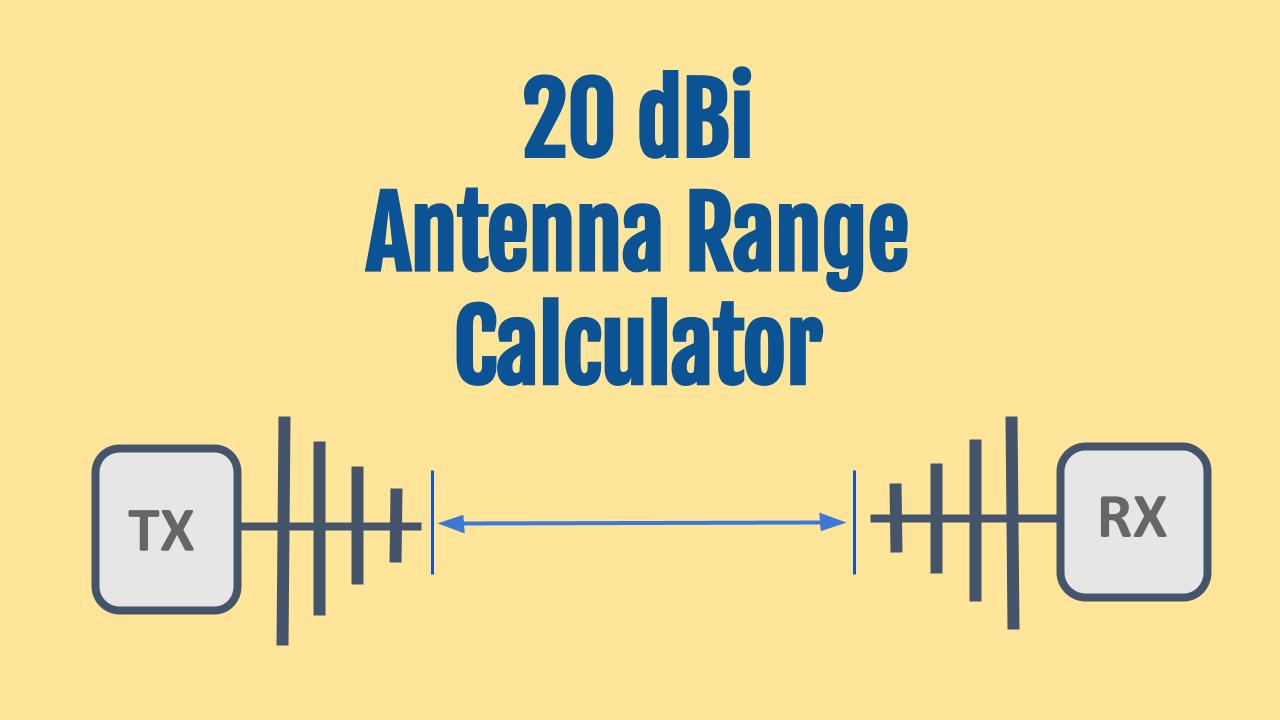This tool computes the maximum range or distance that can be achieved with a 20 dBi gain antenna.
The communication system includes a transmitter, receiver, antennas and cables.
Calculator
To calculate the max distance, enter the following:
- Frequency of operation (Hz/KHz/MHz/GHz)
- Transmit Power (dBm)
- Receiver Sensitivity (dBm)
- Receive Antenna Gain (dBi) – the default value is 2 dBi
- Total Cable and Other Losses (dB)
Formula
The calculator uses the Free Space Path Loss (FSPL) equation:
PTx – PRx = 20*Log10(d) + 20*Log10(f) + Lc + 20*Log10(4π/c) – GTx – GRx
The distance d is given by
Log10(d) = (1/20)*(PTx – PRx – Lc + GTx + GRx – 20*Log10(f) – 20*Log10(4π/c))
Example Range Calculation
At a frequency of 1000 MHz and transmit power of +10 dBm, let’s calculate the range for a 20 dBi antenna
With
- Receiver sensitivity = -90 dBm,
- Receive antenna gain = 2 dBi, and
- Cable loss = 0 dB
the maximum range is 30,035 meters or 30 km.
Important to remember that this calculation is outdoors and free space which represents an ideal signal propagation condition. In practice, the range would be lower
Try the Free Space Path Loss (FSPL) Calculator
If you want to use a 20 dBi (receive) antenna for TV signal reception, use the calculator above. Consider the frequency of operation, transmitter power (in the kW range) and transmit antenna gain.
How to use the calculator
Below is a list of the terms used in the calculator and what each of them mean.
Frequency of operation
This is the frequency at which the communication system operates. At lower frequencies, wavelength is commonly used.
Transmit Power
This is the power at the output connector of the transmitter. It is usually specified in dBm. However many vendors specify this quantity in Watt.
Transmit Antenna Gain
This depends on the type of antenna used and is expressed in dBi (dB relative to isotropic antenna).
Total Cable and Other Losses
This includes losses between connectors and antennas. If RF Splitters are used, the loss should be accounted for as well. It is specified in dB.
The sum of the Transmit antenna power and Gain minus cable and connector losses is also called Effective Isotropic Radiated Power or EIRP for short.
Receiver Sensitivity
Minimum level of input signal that a radio receiver can detect and demodulate. Use this calculator to find the sensitivity as a function of temperature, SNR and receiver noise figure.
✨ Receiver Sensitivity calculator
Receive Antenna Gain
This quantity depends on antenna used and is expressed in dBi. In cases where the signal is from a particular direction, a high gain Rx antenna (8 dBi for instance) can be used. This allows focusing of energy instead of receiving from all directions.
What is a 20 dBi antenna used for?
A 20 dBi antenna is a high-gain antenna commonly used in communication systems that require long-range, focused signals. “dBi” stands for decibels relative to an isotropic radiator, which measures the gain or signal amplification of the antenna compared to a theoretical, omnidirectional source. A higher dBi value, such as 20 dBi, indicates that the antenna concentrates the radio frequency (RF) energy more narrowly, resulting in increased signal strength over long distances.
References
[1] Free Space Path Loss on Wikipedia
